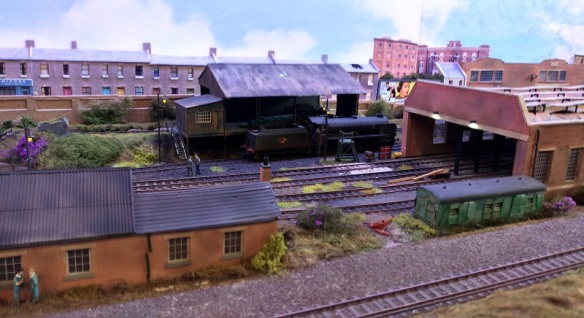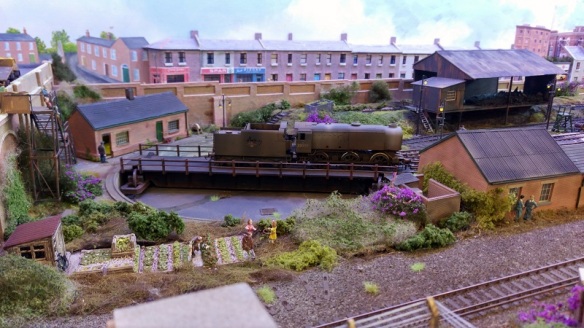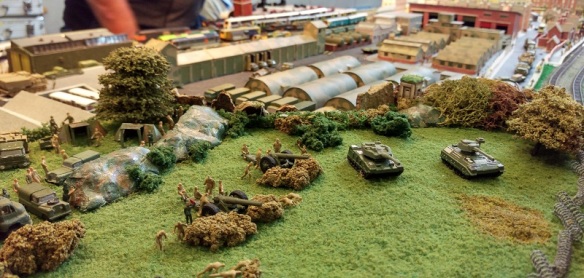Just like last week’s post, this week’s is a how-to regarding DCC electronics. In particular it’s about DCC auto reversers, and how to quickly test they are working.
Why test them? Well if you have one installed and the system isn’t working it’s a good idea to test the auto reverser away from the layout as it may not be the part at fault. In that case changing it won’t help.
Before I show you how I test them, I will explain how an auto reverser works, and why we need them as I often get asked this.
Imagine you have a straight railway and at one end you have a single point/turnout. The first track coming out of the point leads to the other via a loop or balloon as in the image below.

This allows you to turn a train around but it also creates a problem in that the rails will short each other out. If you look at the image again you see that the upper rail in the straight section runs around the loop and connects to the lower rail. This is called a dead short.
To stop this, both rails need to be isolated in two places and in this situation it makes sense to do it just after the point, as shown below.

The power to the loop can then be supplied separately allowing the polarity to be switched. This allows a train to run into the loop and stop. Then a switch is thrown reversing the polarity of the loop power. The point/turnout is changed and the train can then proceed back onto the line facing the other way without shorting.
But what if the switch was set the wrong way upon entering the loop? The train will short. The same applies if you forget to stop the train; it will short when it tries to leave the loop.
This is where the auto reverser comes in. This device automatically reverses the polarity of the track it’s supplying when it detects a short. Normally when a DCC command station detects a short it shuts the power off so nothing gets damaged. (Shorting electrical circuits cause lots of heat which is not a good combination with model trains!) However, the auto reverser detects the shorts and changes the polarity faster than the command station can react, therefore avoiding a shutdown. This allows a DCC train to run around the loop, assuming the point/turnout is changed, and back out onto the line without stopping or stuttering.
Wiring in an auto reverser is fairly simple, but sometimes you may need to test it to see if it’s working without connecting it up to the layout. Below is a typical auto reverser.

Normally they have an input side and a switched output side. For this one the input is the two red wires. For the test I have simply used a section of track which is connected to my DCC command station at my work bench. I quickly soldered the two red wires to the rails, it doesn’t matter which wire goes to which rail.

Then starting with one of the yellow wires, I touch it to one of the rails. At the heart of the auto reverser is a relay and you can normally hear it trigger when one of the wires touches a rail of the opposite polarity. At this stage if the command station beeps or shuts down due to a short, the auto reverser is faulty. Assuming the command station did not shut down, do the same with the other yellow wire. Then do both together, but always on different rails as the yellow wires should not touch each other. If that works well then the auto reverser is working properly and is ready to be installed into your layout.
If you wanted to test your auto reverser because it wasn’t working when installed, but it passes the test above, then here are some other things to check.
Are both rails in your reversing section isolated from the rest of the layout? This may cause the loop to work in one direction but not the other.
Is the auto reverser installed the right way round? The DCC supply needs to be connected to the input side.
Is the reversing section too short? It needs to be longer than your longest train otherwise the front will try and trigger the auto reverser and the rear will try and put it back.
Is the section you are reversing drawing too much current? For example: is the section you are reversing a whole staging yard with lots of locomotives in? Most auto reversers are only designed for about 1 amp and several sound locos could be drawing a lot more.
Is the auto reverser close to the section you are reversing? The further away it is the longer the wires and the higher the chance of resistance in the wire affecting the short detection circuitry.
Are the DCC wires and track feed wires bunched together? Having the positive and negative wires directly next to each other can cause problems with the DCC signal due to inductance. This is the magnetic field generated by each wire affecting its neighbour.
Hopefully this will help in diagnosing any problems you may be having with your auto reversing sections.
Next week I plan to share with you my designs for another 3D printed project, this one should be the first of several I have on the drawing board.





 The beautiful T9 on the right reminds me of my trip to the
The beautiful T9 on the right reminds me of my trip to the 

























 Again O Scale is fantastic for detail and this GWR tank looks just like the real thing.
Again O Scale is fantastic for detail and this GWR tank looks just like the real thing.





















You must be logged in to post a comment.